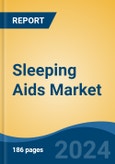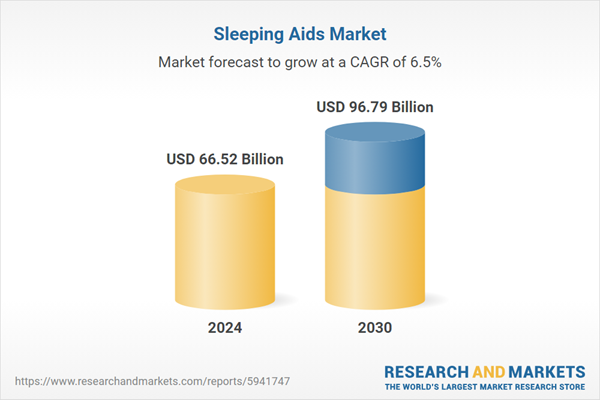Hospital Pharmacies is the fastest growing segment, North America is the largest regional market
Speak directly to the analyst to clarify any post sales queries you may have.
10% Free customizationThis report comes with 10% free customization, enabling you to add data that meets your specific business needs.
Key Market Drivers
The increased prevalence of sleep disorders significantly drives the global sleeping aids market. As populations contend with conditions such as insomnia and sleep apnea, demand for effective diagnostic tools and therapeutic interventions grows. For instance, according to a survey commissioned by the American Academy of Sleep Medicine, in June 2024, 12% of Americans reported a diagnosis of chronic insomnia, highlighting a substantial segment of the population seeking relief.Key Market Challenges
A significant challenge impeding market expansion in the Global Sleeping Aids Market is the ongoing concern regarding the potential side effects and dependency risks associated with certain prescription sleep medications. This apprehension directly influences consumer behavior, often leading individuals to prefer non-pharmacological alternatives or to discontinue treatment. This reluctance to use or continue prescription sleep aids directly hampers market growth in specific product segments.For instance, according to the American Academy of Sleep Medicine's 2024 Sleep in America poll, 38% of adults who experience sleep difficulties reported actively avoiding prescription sleep medication due to worries about potential side effects or addiction. This consumer shift limits sustained market expansion for pharmaceutical solutions, as a substantial portion of the target demographic opts for perceived safer options. The market consequently experiences constrained growth in segments reliant on prescription sales, impacting overall adoption rates and the potential for greater market penetration.
Key Market Trends
The increasing consumer preference for natural and herbal sleep aids is significantly reshaping the global sleeping aids market. Consumers are increasingly seeking alternatives to traditional pharmaceutical options, driven by concerns about potential side effects and dependency risks associated with prescription medications. This shift is expanding the market beyond conventional offerings toward botanical and supplement-based solutions.According to the Council for Responsible Nutrition 2024 Consumer Survey, published in October 2024, magnesium usage among supplement users rose from 19% in 2023 to 23% in 2024, while ashwagandha use increased from 2% in 2020 to 8% in 2024, reflecting growing interest in ingredients often found in natural sleep aids. This rising demand encourages innovation and product development in the natural segment. For instance, in May 2024, Natrol, a prominent melatonin brand, introduced Time Release Melatonin gummies, designed for dual-action delivery to assist with both falling and staying asleep, catering to this evolving consumer preference.
Key Market Players Profiled:
- AstraZeneca Plc
- BMC Medical Co., Ltd.
- Cadwell Industries, Inc
- Compumedics Limited
- Drive DeVilbiss Healthcare Inc
- Eisai Co. Ltd.
- Fisher & Paykel Healthcare Limited
- GlaxoSmithKline Plc
- Idorsia Pharmaceuticals Ltd
- Koninklijke Philips N.V
Report Scope:
In this report, the Global Sleeping Aids Market has been segmented into the following categories:By Product Type:
- Mattresses & Pillows
- Medications
- Sleep Apnea Devices
- Others
By Sleep Disorder:
- Insomnia
- Narcolepsy
- Restless Leg Syndrome
- Sleep Apnea
- Others
By Distribution Channel:
- Hospital Pharmacies
- Retail Pharmacies
- E-commerce
- Drug Stores
- Others
By Region:
- North America
- Europe
- Asia-Pacific
- South America
- Middle East & Africa
Competitive Landscape
Company Profiles: Detailed analysis of the major companies present in the Global Sleeping Aids Market.Available Customizations:
With the given market data, the publisher offers customizations according to a company's specific needs. The following customization options are available for the report.Company Information
- Detailed analysis and profiling of additional market players (up to five).
This product will be delivered within 1-3 business days.
Table of Contents
Companies Mentioned
The companies profiled in this Sleeping Aids market report include:- AstraZeneca Plc
- BMC Medical Co., Ltd.
- Cadwell Industries, Inc
- Compumedics Limited
- Drive DeVilbiss Healthcare Inc
- Eisai Co. Ltd.
- Fisher & Paykel Healthcare Limited
- GlaxoSmithKline Plc
- Idorsia Pharmaceuticals Ltd
- Koninklijke Philips N.V
Table Information
| Report Attribute | Details |
|---|---|
| No. of Pages | 187 |
| Published | November 2025 |
| Forecast Period | 2024 - 2030 |
| Estimated Market Value ( USD | $ 66.52 Billion |
| Forecasted Market Value ( USD | $ 96.79 Billion |
| Compound Annual Growth Rate | 6.4% |
| Regions Covered | Global |
| No. of Companies Mentioned | 11 |









